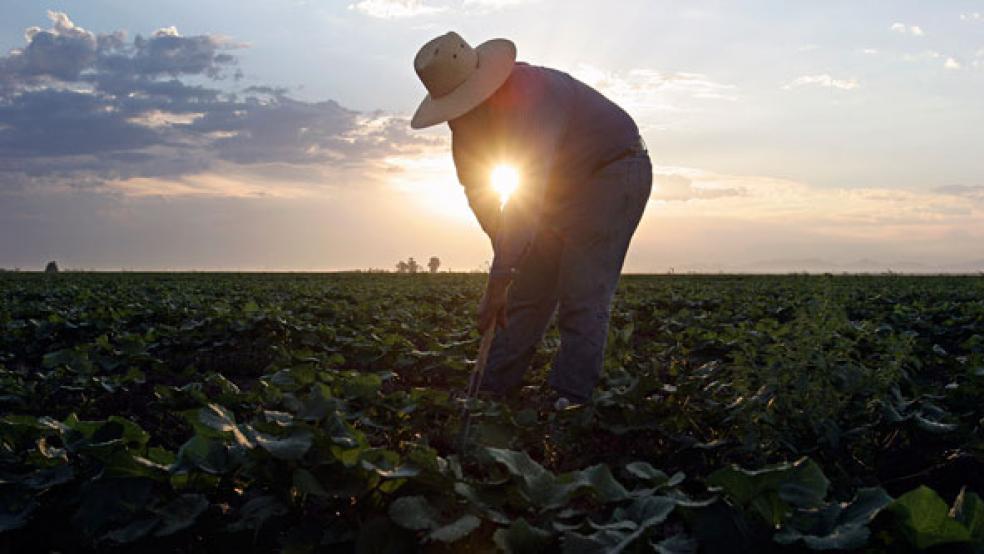Sen. Chuck Schumer (D-NY) is taking a victory lap on immigration reform, after having brokered a deal between the AFL-CIO and the U.S. Chamber of Commerce to establish a new visa program to allow more low-skilled workers into the country.
But the numbers indicate that this is a political win, not necessarily an economic one for the hundreds of thousands undocumented immigrants who are janitors, hotel maids, construction workers, nursing home aides—the kinds of low-wage jobs that many American citizens have shunned.
For this part of the debate, what really matters are the details of how many people are granted visas relative to the demand, and whether the costs of navigating the federal bureaucracy exceed the benefits for companies. Early estimates indicate that the visas would only cover a sliver of illegals, and that more attention should be directed toward fixing the bureaucratic obstacles that have hampered similar types of existing visa programs.
The existing H-2A visas for the agricultural sector is a case study for the need to ensure that new programs targeted at a different group of workers aren’t laden with red tape. The problem is so pronounced that the farm lobby is separately pushing for a new type of visa, a lesson that will need to inform the “W” program.
“The reason why the H-2A program is badly broken is it is rigid, bureaucratic, and expensive to operate under,” said Kristi Boswell, director of congressional relations at the American Farm Bureau Federation.
Schumer sees the agreement as overcoming the last major hurdle so that the bipartisan Gang of Eight—which includes GOP star Florida Sen. Marco Rubio—can finalize a broader reform that would enable 11 million illegals to start on a 13-year pathway to citizenship.
“Every major policy issue has been resolved,” Schumer said on NBC’s “Meet the Press.” “I’m very optimistic that we’ll have an agreement among the eight of us next week.”
Under the proposed “W” visa program -- a guest visa for low-skilled workers – 20,000 would be approved to enter the United States beginning on April 1, 2015. The number would increase to 35,000 in 2016 and reach 75,000 by the fourth year. After that point, the visas granted would be decided by a new federal agency based on unemployment rates and job openings—with no more than 200,000 W visas getting granted.
These workers in theory compete in jobs with a heavy union presence, so the AFL-CIO pushed for a smaller cap than what the business lobby supported. And as a result of that agreement, there are still thousands upon thousands of these workers who will still be flowing into this country illegally.
The National Journal notes that 165,000 entered the United States in 2011 looking for work in these professions—more than eight times the number of visas that would be granted in 2015. If the decade-long average of 350,000 low-skilled illegal immigrants crossing each year holds, there might still be hundreds of thousands still toiling in the economic shadows.
But one of the real problems is the complexity of navigating the federal bureaucracy. If the “W” visa isn’t user friendly, employers may continue to rely on undocumented workers. Employers might not be able to plan effectively for their needs if all decisions are based on a fluctuating unemployment rate and other factors assessed by a presidential appointee.
Consider the existing H-2A visa for agricultural and seasonal workers created by the 1986 overhaul. It has no statutory limits but plenty of bureaucratic hassles. Employers must first prove that there are not enough qualified American workers available, attempt to recruit Americans first, and ensure that the hiring of foreigners will not hurt wages for their American employees, among other requirements.
The Congressional Research Service noted in a December, 2012 report that more than 89,000 H-2A visas were requested for 2010, of which 79,011 were approved. That is a fraction of the roughly 750,000 people employed seasonally on farms, according to the Agriculture Department.
“Despite its growth since the early 1990s, the H-2A program remains quite small relative to total hired farm employment,” the Congressional Research Service concluded.
Tom Nassif, president and CEO of the Western Growers Association, told the Senate Judiciary Committee in 2011, “H-2A is administratively burdensome, implemented ineffectively, and is too unresponsive and inflexible to meet the labor needs of U.S. agriculture.”
He said the bureaucratic delays from the program imposed $320 million in costs on its participating companies, which are also more likely to face compliance audits of its employees.
“It is utterly failing the agricultural industry,” Nassif concluded.



